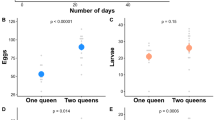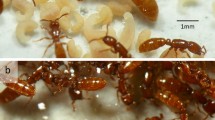Abstract
The success of an ant colony depends on the simultaneous presence of reproducing queens and non-reproducing workers in a ratio that will maximize colony growth and reproduction. Despite its presumably crucial role, queen–worker caste ratios (the ratio of adult queens to workers) and the factors affecting this variable remain scarcely studied. Maintaining polygynous pharaoh ant (Monomorium pharaonis) colonies in the laboratory has provided us with the opportunity to experimentally manipulate colony size, one of the key factors that can be expected to affect colony level queen–worker caste ratios and body size of eclosing workers, gynes and males. We found that smaller colonies produced more new queens relative to workers, and that these queens and workers both tended to be larger. However, colony size had no effect on the size of males or on the sex ratio of the individuals reared. Furthermore, for the first time in a social insect, we confirmed the general life history prediction by Smith and Fretwell (Am Nat 108:499–506, 1974) that offspring number varies more than offspring size. Our findings document a high level of plasticity in energy allocation toward female castes and suggest that polygynous species with budding colonies may adaptively adjust caste ratios to ensure rapid growth.


Similar content being viewed by others
References
Anderson K.E., Linksvayer T.A. and Smith C.R. 2008. The causes and consequences of genetic caste determination in ants (Hymenoptera: Formicidae). Myrmecol. News 11: 119-132
Berndt K.P. and Eichler W. 1987. Die Pharaoameise, Monomorium pharaonis (L.) (Hym., Myrmicidae). Mitt. Zool. Mus. Berl. 63: 3 -186
Bourke A.F.G. and Franks N.R. 1995. Social Evolution in Ants. Princeton University Press, Princeton, New Jersey. 529 pp
Bourke A.F.G. and Ratnieks F.L.W. 1999. Kin conflict over caste determination in social Hymenoptera. Behav. Ecol. Sociobiol. 46: 287-297
Buczkowski G. and Bennett G. 2009. Colony budding and its effects on food allocation in the highly polygynous ant, Monomorium pharaonis. Ethology 115: 1091-1099
Crozier R.H. and Pamilo P. 1996. Evolution of Social Insect Colonies: Sex Allocation and Kin Selection. Oxford University Press, New York. 306 pp
Edwards J.P. 1986. The biology, economic importance, and control of the Pharaoh’s Ant. In: Economic Impact and Control of Social Insects (S.B. Vinson, Ed). Praeger Publishers, New York, pp 257-271
Edwards J.P. 1987. Caste regulation in the pharaoh’s ant Monomorium pharaonis: the influence of queens on the production of new sexual forms. Physiol. Entomol. 12: 31-39
Edwards J.P. 1991. Caste regulation in the pharaoh’s ant Monomorium pharaonis: recognition and cannibalism of sexual brood by workers. Physiol. Entomol. 16: 263-271
Glancey B.M. and Lofgren C.S. 1988. Adoption of newly-mated queens; a mechanism for proliferation and perpetuation of polygynous red imported fire ants, Solenopsis invicta, Buren. Florida Entomol. 71: 581-587
Hughes W.O.H. and Boomsma J.J. 2008. Genetic royal cheats in leaf-cutting ant societies. Proc. Natl. Acad. Sci. U. S. A. 105: 5150-5153
Hölldobler B. and Wilson E.O. 1990. The Ants. Springer, New York. 732 pp
Jaffe R., Kronauer D.J.C., Kraus F.B., Boomsma J.J. and Moritz R.F.A. 2007. Worker caste determination in the army ant Eciton burchellii. Biol. Lett. 3: 513-516
Klobuchar E.A. and Deslippe R.J. 2002. A queen pheromone induces workers to kill sexual larvae in colonies of the red imported fire ant (Solenopsis invicta). Naturwissenschaften 89: 302-304
McGlynn T.P. and Owen J.P. 2002. Food supplementation alters caste allocation in a natural population of Pheidole flavens, a dimorphic leaf-litter dwelling ant. Insect. Soc. 49: 8-14
Nonacs P. 1988. Queen number in colonies of social Hymenoptera as kin-selected adaptation. Evolution 42: 566-580
Nonacs P. 1993. The effects of polygyny and colony life history on optimal sex investment. In: Queen Number and Sociality in Insects (L. Keller, Ed). Oxford University Press, New York, pp 110-131
Oster G.F. and Wilson E.O. 1978. Caste and Ecology in the Social Insects, vol 12. Princeton University Press, Princeton, New Jersey. 352 pp
Pamilo P. 1991. Evolution of colony characteristics in social insects .1. sex allocation. Am. Nat. 137: 83-107
Passera L., Roncin E., Kaufmann B. and Keller L. 1996. Increased soldier production in ant colonies exposed to intraspecific competition. Nature 379: 630-631
Peacock A.D. and Baxter A.T. 1949. Studies in Pharaoh’s ant, Monomorium pharaonis (L.). 1. The rearing of artificial colonies. Entomol. Mon. Mag. 85: 256-260
Petersen-Braun M. 1975. Investigations on social organization in Pharaohs ant, Monomorium pharaonis L (Hym Formicidae) 1. Regulation of brood cycle. Insect. Soc. 22: 269-291
Petersen-Braun M. 1977. Investigations on social organization of Pharaohs ant Monomorium pharaonis L (Hymenoptera, Formicidae) 2. Caste determination. Insect. Soc. 24: 303-318
Porter S.D. and Tschinkel W.R. 1985a. Fire ant polymorphism (Hymenoptera: Formicidae): factors affecting worker size. Ann. Entomol. Soc. Am. 78: 381-386
Porter S.D. and Tschinkel W.R. 1985b. Fire ant polymorphism: the ergonomics of brood production. Behav. Ecol. Sociobiol. 16: 323-336
R Development Core Team. 2009. R: A Language and Environment for Statistical Computing. R Foundation for Statistical Computing, Vienna, Austria. ISBN 3-900051-07-0, URL http://www.R-project.org.
Rüppell O. and Heinze J. 1999. Alternative reproductive tactics in females: the case of size polymorphism in winged ant queens. Insect. Soc. 46: 6-17
Schmidt A.M., d’Ettorre P. and Pedersen J.S. 2010. Low levels of nestmate discrimination despite high genetic differentiation in the invasive pharaoh ant. Front. Zool. 7: 20
Schwander T., Humbert J.-Y., Brent C.S., Cahan S.H., Chapuis L., Renai E. and Keller L. 2008. Maternal effect on female caste determination in a social insect. Curr. Biol. 18: 265-269
Schwander T., Lo N., Beekman M., Oldroyd B.P. and Keller L. 2010. Nature versus nurture in social insect caste differentiation. Trends Ecol. Evol. 25: 275-282
Smith C.C. and Fretwell S.D. 1974. Optimal balance between size and number of offspring. Am. Nat. 108: 499-506
Tschinkel W.R. 1993. Sociometry and sociogenesis of colonies of the fire ant Solenopsis invicta during one annual cycle Ecol. Monogr. 63: 425-457
Vargo E.L. and Fletcher D.J.C. 1986. Evidence of pheromonal queen control over the production of male and female sexuals in the fire ant, Solenopsis invicta. J. Comp. Physiol. A-Sens. Neural Behav. Physiol. 159: 741-749
Vargo E.L. and Passera L. 1991. Pheromonal and behavioral queen control over the production of gynes in the Argentine ant Iridomyrmex humilis (Mayr). Behav. Ecol. Sociobiol. 28: 161-169
Wheeler D.E. 1986. Developmental and physiological determinants of caste in social Hymenoptera: evolutionary implications. Am. Nat. 128: 13-34
Wilson E.O. 1983. Caste and division of labor in leaf-cutter ants (Hymenoptera, Formicidae, Atta). 4. Colony ontogeny of Atta cephalotes. Behav. Ecol. Sociobiol. 14: 55-60
Acknowledgments
We thank Christa Funch Jensen, Isabel Højgaard Rasmussen, Markus Drag, Mathilde Lerche-Jørgensen, Nathia Hass Brandtberg and Signe Lolle for help sorting, feeding, and measuring ants. The study was supported by The Danish National Research Foundation (AMS, JJB, JSP) and an EU Marie Curie International Incoming Fellowship (TAL).
Author information
Authors and Affiliations
Corresponding author
Rights and permissions
About this article
Cite this article
Schmidt, A.M., Linksvayer, T.A., Boomsma, J.J. et al. Queen–worker caste ratio depends on colony size in the pharaoh ant (Monomorium pharaonis). Insect. Soc. 58, 139–144 (2011). https://doi.org/10.1007/s00040-010-0126-x
Received:
Revised:
Accepted:
Published:
Issue Date:
DOI: https://doi.org/10.1007/s00040-010-0126-x




